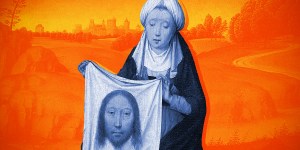Acheiropoieta are icons made without hands. Far from implying these images were made using an image-generating AI software à la Midjoyrney, an acheiropoieton is a type of icon (or any other kind of religious image, mostly two-dimensional) believed to have been miraculously created by supernatural means or by divine intervention – that is, without the use of human hands. The word itself is made from the Greek prefix a (meaning “not”) preceding the word cheiropoietos, meaning “handmade.”
In the Western Christian tradition there are several famous examples of acheiropoieta, the most widely known of them all perhaps being the Veil of Veronica – although the Shroud of Turin and the image of Our Lady of Guadalupe also hold exceptionally special status among the faithful.
According to tradition, Veronica was a woman (apparently from Jerusalem) who, seeing Jesus carrying the cross along the Via Dolorosa, was moved with compassion and handed him her veil so that he could wipe the blood and sweat from his forehead.
When Jesus returned the veil, the image of his face was miraculously imprinted on it. The relic became then widely known as the “Veil of Veronica,” in what seems to be a kind of pun. The sources from which the story is drawn are all in Greek (the name being Berenikē or Beronike, meaning “she who brings victory”); the Latinized Veronica allegedly translates “the true image,” the vero icono of Christ. Ironically enough, several existing images claim to be the original, true relic.

Now, the name Veronica (or the original Greek Beronike) is nowhere to be found in the Bible. The same goes for her veil. All of the sources for her story come from extra-biblical Christian tradition, which has commonly assigned this identity to the unnamed woman who hemorrhaged blood for 12 years until she touched the edge of Christ’s garment and was miraculously healed. That passage is found in the three synoptic Gospels (Cf. Mark 5:25–34; Matthew 9:20–22; and Luke 8:43–48). While the legend of Veronica’s veil is not based on Scripture, the story of a passerby offering kindness to Jesus on his way to Calvary may well be based in some fact, passed on through oral tradition, collected in the apocryphal Gospel of Nicodemus, mentioned in the famous Historia Ecclesiastica (written somewhere between the years 312 and 324 by Eusebius of Caesarea) and then developed throughout the centuries in other apocryphal texts.
More acheiropoieta
In the Orthodox Christian tradition, there are also many examples of acheiropoieta, such as the Mandylion of Edessa – a cloth that is believed to bear the image of Christ’s face, almost the Eastern version of Veronica’s Veil.
Acheiropoieta are often the subject of intense veneration, as they are considered exceptional testimonials of God’s presence, and thus powerful instruments of divine grace. It is often the case that the faithful go on pilgrimages to pray before these miraculous images, seeking spiritual and physical healing – or simply to express their faith, love, and devotion.




